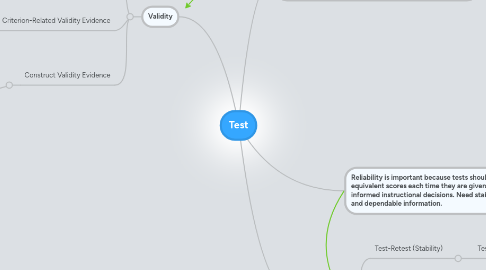
1. Validity
1.1. Content Validity Evidence
1.1.1. Questions correspond with what is being tested. Items match objectives
1.2. Criterion-Related Validity Evidence
1.2.1. Scores are correlated to outside criterion
1.2.1.1. Concurrent
1.2.1.1.1. The new test scores correlate to test scores from an established test.
1.2.1.2. Predictive
1.2.1.2.1. Results are checked after a time to see if they match what was predicted
1.3. Construct Validity Evidence
1.3.1. Results are correlated to theory (or what was expected)
2. Reliability
2.1. Test-Retest (Stability)
2.1.1. Test is given twice, scores should correlate
2.2. Alternate Forms (Equivalency)
2.2.1. Each equivalent form of the test produce scores that correlate.
2.3. Internal Consistency
2.3.1. Items should correlate with each other
2.3.1.1. Split Halves method
2.3.1.1.1. Items are separated into two groups, group scores correlate
2.3.1.2. Kuder-Richardson method
2.3.1.2.1. Items in one form of test are similar and correlate to items in an equivalent form of the test
